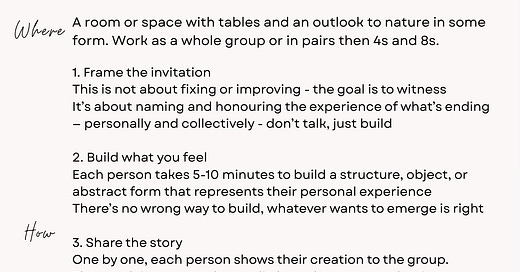Grief doesn’t move well through spreadsheets. It struggles inside tidy frameworks. It resists the cold logic of cause and effect, preferring to surface in ways that are more bodily — a tightening in the throat, a reluctance to revisit a document, a sharp edge in the way we speak to each other after something important has ended.
That’s why organisational grief work needs to be embodied — felt, handled, built with our hands. When we try to process collective grief only through conversation, it tends to stay in the head — stuck in analysis, rationalization, or premature sense-making. But when we invite the body and hands into the process, a different kind of knowing emerges — one that can hold complexity without rushing to resolution.
This is where the Collective Composting practice comes in. I’ve used it with teams after projects, after restructuring, and after moments of deep collective change. It’s simple, playful — but also profoundly effective at surfacing the grief we don’t know how to name.
The invitation is straightforward:
Each person builds something with LEGO — a shape, a structure, an abstract form — that represents their personal experience of what’s ending. Then, piece by piece, they walk the group through it. The hands speak first, before the mind catches up.
It’s astonishing what surfaces when we let the hands take the lead. People build fragments, bridges, collapsing towers, fragile boats, mazes with no exits. They build things they didn’t know they were holding — metaphors made visible. What emerges is not a post-mortem, but a shared ritual of mourning, witnessing, and honouring.
Because grief in organisations isn’t just about what we built together — it’s also about what we believed in together. The values we thought we were living. The stories we told ourselves about what we were making and why it mattered. When those stories unravel, the grief is not just personal — it’s relational, stretching across teams, projects, and years.
The LEGO practice is a small way of making space for that grief without apology, and without needing to immediately reframe it as learning. Sometimes, what needs to happen first is simply letting the hands speak, being witnessed, and knowing the grief belongs not just to you, but to the collective.
This is composting work — the slow, relational unravelling that makes room for something new. Not in the urgency of innovation, but in the gentle recognition that grief is the soil for what comes next.
Want a printable version? Download the PDF here
Invitation: Share a Letter to the Drift
If something arose for you — a sensation, a memory, a grief you’ve been holding quietly — you’re welcome to send a Letter to the Drift. These letters are part of the larger compost we’re tending, fragments of your story woven into this unfolding practice.
Letters don’t need to be polished or certain. They can be incomplete, raw, or full of wonderings you haven’t yet untangled. Some letters will rest quietly between us. Some, with your blessing, may become part of future posts — a living archive of our collective unravelling.
This space isn’t a forum, but a series of quiet correspondences. If something stirs in you while reading — a memory, a question, a grief, a seed — you’re invited to write back via ‘Letters to the Drift’. Some letters will find their way into future posts, if you’re willing to share. Others will rest quietly between us.
The comments are closed, but the conversation is alive.






